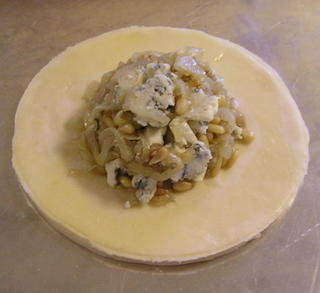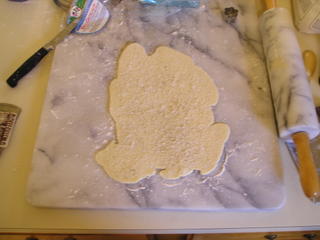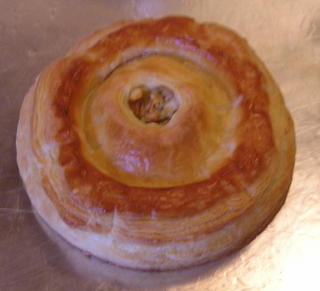Pithiviers

A good deal of my culinary knowledge begins and ends with Julia Child and comes from the days when I was an undergraduate in Boston and would rather watch one of the many reruns of one of her series than do something silly like go to class. And I'm sure that the only two times I've seen a Pithviers made were by Julia. To the best of my knowledge (and for heaven's sake feel free to correct me either by comment or email if I make a mistake on culinary history or, you know, grammar, where grammatical mistakes do not include run-on sentences because, after all, if you had to comment or email me once for each of my run-on sentences, you'd have little time to do anything else), only one of them was really a Pithiviers; the second was a savory tart in the form of a Pithiviers. I believe that a true Pithiviers is a dessert and that the filling is some sort of almond cream, but I am too lazy to look it up, and if I did look it up, I would have no way of being certain that my source was authoritative, though I reckon I could go downstairs and look in my Larousse Gastronomique, which I picked up at the church bazaar last year for two bucks*.
Since I had very recently made a few pounds of puff pastry, and since I have always wanted to make a Pithiviers, or at least something in the shape of a Pithiviers, I figured now was a good time to give it a try. I wasn't looking to make a dessert, however, so I went with something savory.
In form, a Pithiviers is two circles of puff pastry with a solid filling. The first circle of puff pastry is placed on your baking sheet and then the filling is mounded in the center. Then the second circle is placed on top of the filling and sealed to the unfilled part at the edges of the first circle. It all goes into a very hot oven until the puff pastry is done.
I reckon that you can use any fairly solid filling for a Pithiviers. I had a couple of Vidalia onions in the refrigerator, so I sliced half of one thin and cooked it very slowly in a tablespoon of olive oil until it got very soft. Then I turned the heat up to medium and cooked the onion until it had caramelized somewhat. At the same time, I toasted two tablespoons of pine nuts in the toaster oven, and I preheated my main oven to 425 degrees. When the onions were nicely browned, I added a good pinch of kosher salt and a grinding of pepper. Then I stirred in the pine nuts. Finally, I removed the whole shebang from the heat, and I stirred in about two ounces of crumbled gorgonzola. If I were making the same dish again, I would add a half tablespoon or so of balsamic vinegar to the onions while they were cooking.
 I took one of the three pieces of puff pastry that I'd made earlier, and I rolled it out to a thickness of about a quarter inch*. Then I took a pot lid with a diameter of about 7 inches, and using it as a template, I cut out two circles of dough with a paring knife. I put one circle on my half sheet pan, and mounded as much of the filling in the center of the circle as I could manage while still leaving about an inch free around the edge. Then I painted the edge with an egg wash.
I took one of the three pieces of puff pastry that I'd made earlier, and I rolled it out to a thickness of about a quarter inch*. Then I took a pot lid with a diameter of about 7 inches, and using it as a template, I cut out two circles of dough with a paring knife. I put one circle on my half sheet pan, and mounded as much of the filling in the center of the circle as I could manage while still leaving about an inch free around the edge. Then I painted the edge with an egg wash. I took the second circle and rolled it about an inch wider than it had been. Then, with a tiny cutter, I cut a bit out of the center to allow venting. I put the second circle on top of the filling, making sure that it covered the filling fairly tightly without squashing it down. Then I pressed down around the edges to get a good seal. I made a few small decorative cuts through both layers of the edge of the pastry with my paring knife, and then I covered the top pastry with some more egg wash. Then right into the 425 degree oven for 25 minutes.
I took the second circle and rolled it about an inch wider than it had been. Then, with a tiny cutter, I cut a bit out of the center to allow venting. I put the second circle on top of the filling, making sure that it covered the filling fairly tightly without squashing it down. Then I pressed down around the edges to get a good seal. I made a few small decorative cuts through both layers of the edge of the pastry with my paring knife, and then I covered the top pastry with some more egg wash. Then right into the 425 degree oven for 25 minutes. When you're cooking puff pastry of any sort, you want a fairly hot oven, and you don't want to open the oven to look at it for at least fifteen minutes. This practice is as much for your benefit as for the benefit of your pastry. In the initial stages of baking, puff pastry mostly looks like it's weeping butter, but if you wait until it's nearly done, it pulls the butter back in somehow, and everything comes out swell. Also, if you take too much of the heat out of the oven by peeking, you won't get sufficient puff. Generations of neophyte French chefs have been devastated when their professors have looked at their vol-au-vent are whatever and sneered "eeeensuffeeeeshent pooof." Come to think of it, I've known a few insufficient poofs in my time, but perhaps we won't go there just now.
 While you're waiting for your Pithiviers to bake up nicely, you'll probably want to do something with the puff pastry that was leftover when you cut the circles out of it. This is not something that you can waste, even if you can make three pounds of it in an hour and a half. What you want to do is to fit the scraps together as best you can and use your rolling pin to sort of bring them together into a single sheet, which will be not at all regular, but do your best. My favorite thing to do with them at this point is to grate finely some cheese (I used pecorino romano today, but a sharp cheddar would also be yummy) on top of the pastry. Then grind some black pepper on, fold the pastry in thirds as if you were making another turn during the puff pastry creation process, and roll it out to about a quarter inch. Then use a knife to cut it into rectangles of the size you prefer. I made mine about an inch by two inches. Put them on another baking sheet, and when you pull your Pithiviers out of the oven, put your cheese puffs in and bake them for eighteen to twenty minutes, or until they're as done as you like them. Remember not to undercook them, or they won't be crisp.
While you're waiting for your Pithiviers to bake up nicely, you'll probably want to do something with the puff pastry that was leftover when you cut the circles out of it. This is not something that you can waste, even if you can make three pounds of it in an hour and a half. What you want to do is to fit the scraps together as best you can and use your rolling pin to sort of bring them together into a single sheet, which will be not at all regular, but do your best. My favorite thing to do with them at this point is to grate finely some cheese (I used pecorino romano today, but a sharp cheddar would also be yummy) on top of the pastry. Then grind some black pepper on, fold the pastry in thirds as if you were making another turn during the puff pastry creation process, and roll it out to about a quarter inch. Then use a knife to cut it into rectangles of the size you prefer. I made mine about an inch by two inches. Put them on another baking sheet, and when you pull your Pithiviers out of the oven, put your cheese puffs in and bake them for eighteen to twenty minutes, or until they're as done as you like them. Remember not to undercook them, or they won't be crisp. Let your Pithiviers cool when it comes out of the oven. You can serve it at any temperature you like. The slice in the first picture was taken when it was still fairly warm (it was a great deal flakier and crisper than it appears in that picture). And it was very good when it was still warm, but both the filling and the pastry were significantly better, to my taste, when it had fully cooled. I may make another one because the filling that I made, though it didn't seem like that much before I crumbled in the gorgonzola was twice as much as I could get onto a seven-inch Pithiviers. Perhaps I should have made a slightly larger pastry, but it's fairly rich, and I think that a seven-inch version would make a nice first course for six to eight people at a dinner party. I would perhaps sauce it with a rich rosemary bechamel, but I would have to think about it some more.
Let your Pithiviers cool when it comes out of the oven. You can serve it at any temperature you like. The slice in the first picture was taken when it was still fairly warm (it was a great deal flakier and crisper than it appears in that picture). And it was very good when it was still warm, but both the filling and the pastry were significantly better, to my taste, when it had fully cooled. I may make another one because the filling that I made, though it didn't seem like that much before I crumbled in the gorgonzola was twice as much as I could get onto a seven-inch Pithiviers. Perhaps I should have made a slightly larger pastry, but it's fairly rich, and I think that a seven-inch version would make a nice first course for six to eight people at a dinner party. I would perhaps sauce it with a rich rosemary bechamel, but I would have to think about it some more.For those unfortunate souls who cannot abide blue cheese in any of its manifestations, most goat cheeses would make a good substitution, or you could just go with any cheese that moves you. Or you could go with something else altogether, though the cheese is nice because when it melts it brings the entire filling together. Still, you could fill the Pithiviers with any number of combinations and have something delicious.
* Don't you just love my total lack of consistency with respect to footnotes on this site? Anyway, I happened to be downstairs, and I took a look in my Larousse, and a Gâteau de Pithiviers is, technically, indeed filled with an almond cream made of almonds, eggs, butter, sugar, and rum. Larousse tells you to roll the puff pastry out to a thickness of 1/16 inch, but that's just crazy. Of course, I don't carry a caliper around to measure my dough, and mine probably was closer to 1/8 inch thick than 1/4 inch. Let's call it 3/16 inch and a day.

1 Comments:
Gorgeous!
Post a Comment
<< Home